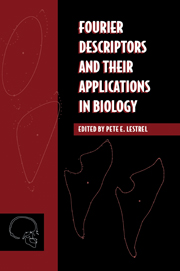Book contents
- Frontmatter
- Contents
- List of contributors
- Preface
- Acknowledgments
- Part one Theoretical considerations
- Part two Applications of Fourier descriptors
- 6 Closed-form Fourier analysis: A procedure for extraction of ecological information about foraminiferal test morphology
- 7 Fourier descriptors and shape differences: Studies on the upper vertebral column of the mouse
- 8 Application of the Fourier method on genetic studies of dentofacial morphology
- 9 Fourier analysis of size and shape changes in the Japanese skull
- 10 Craniofacial variability in the hominoidea
- 11 Heuristic adequacy of Fourier descriptors: Methodologic aspects and applications in Morphological
- 12 Analyzing human gait with Fourier descriptors
- 13 Elliptic Fourier descriptors of cell and nuclear shapes
- 14 Cranial base changes in shunt-treated hydrocephalics: Fourier descriptors
- 15 A numerical and visual approach for measuring the effects of functional appliance therapy: Fourier descriptors
- 16 Size and shape of the rabbit orbit: 3-D Fourier descriptors
- 17 From optical to computational Fourier transforms: The natural history of an investigation of the cancellous structure of bone
- 18 Epilogue: Fourier methods and shape analysis
- Appendix
- Glossary
- Index
11 - Heuristic adequacy of Fourier descriptors: Methodologic aspects and applications in Morphological
Published online by Cambridge University Press: 14 September 2009
- Frontmatter
- Contents
- List of contributors
- Preface
- Acknowledgments
- Part one Theoretical considerations
- Part two Applications of Fourier descriptors
- 6 Closed-form Fourier analysis: A procedure for extraction of ecological information about foraminiferal test morphology
- 7 Fourier descriptors and shape differences: Studies on the upper vertebral column of the mouse
- 8 Application of the Fourier method on genetic studies of dentofacial morphology
- 9 Fourier analysis of size and shape changes in the Japanese skull
- 10 Craniofacial variability in the hominoidea
- 11 Heuristic adequacy of Fourier descriptors: Methodologic aspects and applications in Morphological
- 12 Analyzing human gait with Fourier descriptors
- 13 Elliptic Fourier descriptors of cell and nuclear shapes
- 14 Cranial base changes in shunt-treated hydrocephalics: Fourier descriptors
- 15 A numerical and visual approach for measuring the effects of functional appliance therapy: Fourier descriptors
- 16 Size and shape of the rabbit orbit: 3-D Fourier descriptors
- 17 From optical to computational Fourier transforms: The natural history of an investigation of the cancellous structure of bone
- 18 Epilogue: Fourier methods and shape analysis
- Appendix
- Glossary
- Index
Summary
Setting the Scene
In 1917 and in 1942, D'Arcy Thompson posed the question of size and shape relationships in terms of “Growth and Form” by linking it to two fundamental concepts: (1) basing morphological classifications on a nondimensional type of mathematics (analytical functions); and (2) verifying the “principle of discontinuity,” particularly as this principle occurs in morphogenesis (e.g., chaos/catastrophic theory). It is this rethinking in Systema Naturae terms that Thompson should be remembered for, not just for his well-known method of coordinate transformations. To clarify this we begin by quoting from Thompson:
When we begin to draw comparisons between our algebraic curves and attempt to transform one into another, we find ourselves limited by the very nature of the case to curves having some tangible degree of relation to one another; and these “degrees of relationship” imply a classification of mathematical forms, analogous to the classification of plants or animals in another part of the Systema Naturae. An algebraic curve has its fundamental formula, which defines the family to which it belongs; and its parameters, whose quantitative variation admits of infinite variety within the limits which the formula prescribes
(D'Arcy Thompson, 1942:1093–94).Continuing:
We never think of “transforming” a helicoid into an ellipsoid, … [and] … So it is with the forms of animals. […]
- Type
- Chapter
- Information
- Fourier Descriptors and their Applications in Biology , pp. 250 - 293Publisher: Cambridge University PressPrint publication year: 1997



